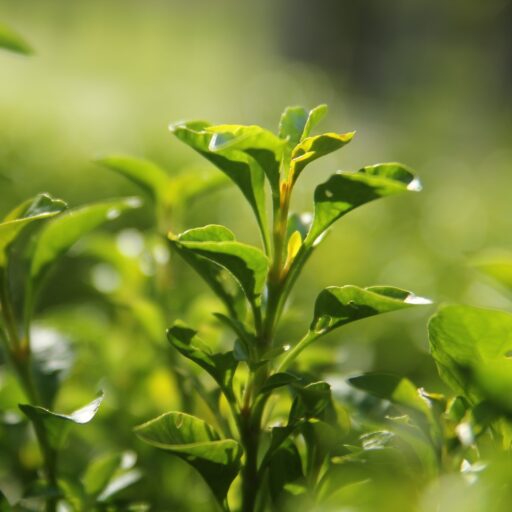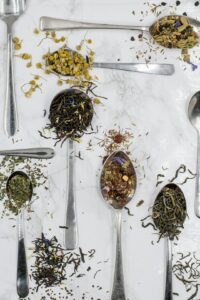Support our educational content for free when you purchase through links on our site. Learn more
Tea Plant Growing Conditions [2023]: How to Cultivate the Perfect Cup of Tea
Table of Contents
- Quick Answer
- Quick Tips and Facts
- Can You Grow Tea Plants at Home?
- How to Plant a Tea Bush
- Choosing the Right Soil for Tea Plants
- Ideal Spacing for Tea Plants
- Sunlight Requirements for Tea Plants
- The Time it Takes for Tea Plants to Grow
- Watering Needs of Tea Plants
- The Versatility of Tea Flowers
- Where to Buy Tea Plants
- FAQ
- Conclusion
- Recommended Links
- Reference Links
Quick Answer
To grow tea plants successfully, you’ll need to provide the right growing conditions. Tea plants thrive in well-drained soil with a pH between 5.5 and 6.5. They require a minimum temperature of 50°F (10°C) and prefer full sun exposure. Tea plants take about 3 to 5 years to reach maturity and produce their first harvest. Regular watering, pruning, and fertilizing are essential for healthy growth. You can purchase tea plants from reputable nurseries or online retailers.
Quick Tips and Facts
- Tea plants (Camellia sinensis) are evergreen shrubs native to East Asia.
- Tea plants can reach heights of up to 10 feet (3 meters) if left unpruned.
- There are different varieties of tea plants, including Camellia sinensis var. sinensis and Camellia sinensis var. assamica.
- Tea plants are hardy in USDA zones 7 to 9.
- The leaves of tea plants are harvested for making various types of tea, such as green, black, oolong, and white tea.
- Tea plants can be grown in containers or directly in the ground, depending on your available space and climate.
Can You Grow Tea Plants at Home?
✅ Yes, you can grow tea plants at home, as long as you provide them with the right growing conditions. Tea plants can be cultivated in both outdoor gardens and indoor pots, depending on your climate and available space. They require well-drained soil, adequate sunlight, and regular care to thrive.
If you live in a region with a suitable climate (USDA zones 7 to 9), you can plant tea bushes directly in your garden. However, if you live in a colder climate, you can still grow tea plants in containers and bring them indoors during the winter months. This allows you to enjoy fresh tea leaves year-round.
How to Plant a Tea Bush
When planting a tea bush, follow these steps:
-
Choose a suitable location: Tea plants prefer a sunny spot with at least 6 hours of direct sunlight per day. Ensure the location has well-drained soil and protection from strong winds.
-
Prepare the soil: Tea plants prefer slightly acidic soil with a pH between 5.5 and 6.5. Test your soil’s pH and amend it if necessary. Dig a hole twice the size of the root ball and mix in organic matter, such as compost or well-rotted manure.
-
Plant the tea bush: Gently remove the tea bush from its container and place it in the hole. Ensure the top of the root ball is level with the soil surface. Backfill the hole with soil and firm it gently around the plant.
-
Water thoroughly: After planting, water the tea bush thoroughly to settle the soil and eliminate air pockets. Keep the soil evenly moist but not waterlogged.
-
Mulch and protect: Apply a layer of organic mulch around the base of the tea bush to conserve moisture and suppress weeds. Protect the plant from extreme temperatures, frost, and strong winds, especially during the first year.
Choosing the Right Soil for Tea Plants
Tea plants thrive in well-drained soil with a slightly acidic pH between 5.5 and 6.5. Here are some tips for choosing the right soil for your tea plants:
-
Texture: Tea plants prefer loamy or sandy soil that allows for proper drainage. Avoid heavy clay soils that retain too much moisture.
-
pH level: Test your soil’s pH level using a soil testing kit. If the pH is too high (alkaline), you can lower it by adding organic matter such as peat moss or compost. If the pH is too low (acidic), you can raise it by adding lime.
-
Organic matter: Incorporate organic matter, such as compost or well-rotted manure, into the soil before planting. This improves soil fertility, structure, and moisture retention.
-
Drainage: Ensure the soil has good drainage to prevent waterlogging, which can lead to root rot. If your soil doesn’t drain well, consider planting tea plants in raised beds or containers filled with well-draining potting mix.
Ideal Spacing for Tea Plants
When planting tea plants, it’s important to give them enough space to grow and thrive. Here are some guidelines for spacing tea plants:
-
In the ground: Space tea plants approximately 3 to 4 feet (90 to 120 cm) apart. This allows them to develop a healthy root system and receive adequate sunlight and air circulation.
-
In containers: If you’re growing tea plants in containers, choose pots that are at least 12 inches (30 cm) in diameter. Plant one tea bush per container to ensure they have enough space for root development.
Proper spacing between tea plants promotes healthy growth, reduces the risk of disease, and makes it easier to prune and harvest the leaves.
Sunlight Requirements for Tea Plants
Tea plants thrive in full sun, but they can tolerate partial shade, especially in hotter regions. Here’s what you need to know about the sunlight requirements for tea plants:
-
Full sun: Tea plants perform best when exposed to at least 6 hours of direct sunlight per day. Full sun promotes vigorous growth, enhances the flavor of the leaves, and increases the plant’s resistance to pests and diseases.
-
Partial shade: If you live in a region with intense heat, tea plants can benefit from some afternoon shade to prevent leaf scorching. However, make sure they still receive a few hours of direct sunlight each day.
Remember to position your tea plants in a location that receives the appropriate amount of sunlight based on your climate and local conditions.
The Time it Takes for Tea Plants to Grow
Tea plants are not fast growers and require several years to reach maturity and produce their first harvest. Here’s a timeline of tea plant growth:
-
Year 1: After planting, tea plants focus on establishing a strong root system. During the first year, they may only grow a few inches in height.
-
Year 2: In the second year, tea plants start to develop more branches and foliage. They may reach a height of 1 to 2 feet (30 to 60 cm) by the end of the year.
-
Year 3: By the third year, tea plants begin to resemble mature bushes. They can grow up to 3 to 4 feet (90 to 120 cm) in height and may produce a small harvest of leaves.
-
Year 4 and beyond: Tea plants continue to grow and mature. By the fourth year and beyond, they can reach heights of up to 5 to 10 feet (1.5 to 3 meters) if left unpruned. They also produce larger harvests of leaves each year.
While it may take a few years for tea plants to reach their full potential, the wait is worth it for the delicious and satisfying cups of tea they can provide.
Watering Needs of Tea Plants
Tea plants require regular watering to ensure healthy growth and leaf production. Here are some tips for watering tea plants:
-
Consistent moisture: Tea plants prefer consistently moist soil. Water them deeply once or twice a week, depending on rainfall and temperature. Avoid overwatering, as it can lead to root rot.
-
Mulch: Apply a layer of organic mulch around the base of the tea plant to help retain soil moisture and prevent weed growth. Mulch also helps regulate soil temperature and protects the roots from extreme temperatures.
-
Monitor soil moisture: Check the soil moisture regularly by inserting your finger into the soil. If it feels dry at a depth of 1 to 2 inches (2.5 to 5 cm), it’s time to water.
-
Watering containers: If you’re growing tea plants in containers, monitor the moisture level more closely, as pots tend to dry out faster. Water the container thoroughly until water drains out of the bottom.
By providing adequate and consistent moisture, you can ensure the health and vitality of your tea plants.
The Versatility of Tea Flowers
Tea flowers, also known as Camellia sinensis flowers, have various uses beyond their ornamental beauty. Here are some ways tea flowers can be used:
-
Tea production: Tea flowers can be harvested along with the leaves and used to make tea. They add a delicate floral aroma and flavor to the brew.
-
Decorative purposes: Tea flowers can be used as a decorative element in floral arrangements or as a garnish for food and drinks. Their vibrant colors and unique shapes make them visually appealing.
-
Infused oils and cosmetics: Tea flowers can be used to infuse oils for use in skincare products or homemade cosmetics. The infused oils can provide nourishing and soothing properties to the skin.
-
Aromatherapy: The fragrance of tea flowers can be used in aromatherapy to promote relaxation and reduce stress. They can be added to potpourri, sachets, or used in essential oil diffusers.
Tea flowers are a versatile and multi-functional component of the tea plant, adding beauty, flavor, and aroma to various aspects of daily life.
Where to Buy Tea Plants
If you’re ready to start growing your own tea plants, you can purchase them from reputable nurseries or online retailers. Here are some options for buying tea plants:
-
Local nurseries: Visit local nurseries or garden centers in your area that specialize in selling plants. They may carry tea plants or be able to order them for you.
-
Online retailers: Many online retailers offer a wide selection of tea plants. Look for reputable sellers that provide detailed information about the plants’ origins, growing conditions, and care instructions.
-
Tea plantations: Some tea plantations sell tea plants directly to consumers. If you have a local tea plantation, reach out to them and inquire about purchasing tea plants.
Before making a purchase, consider the specific variety of tea plant you want, as well as your climate and available space for planting.
FAQ
What are ideal tea growing conditions?
Ideal tea growing conditions include well-drained soil with a pH between 5.5 and 6.5, a minimum temperature of 50°F (10°C), and at least 6 hours of direct sunlight per day. Tea plants also require regular watering, pruning, and fertilizing for optimal growth.
What temperature can tea plants tolerate?
Tea plants are hardy in USDA zones 7 to 9 and can tolerate temperatures as low as 0°F (-18°C) during the dormant period. However, they prefer temperatures between 65°F and 85°F (18°C and 29°C) during the growing season.
Read more about “Tea Plant Growing Conditions [2023]”
Do tea plants need full sun?
Tea plants thrive in full sun and require at least 6 hours of direct sunlight per day. However, they can tolerate partial shade, especially in regions with intense heat. Partial shade can help protect the leaves from scorching.
How far apart should tea plants be spaced?
Tea plants should be spaced approximately 3 to 4 feet (90 to 120 cm) apart in the ground. This allows them to develop a healthy root system and receive adequate sunlight and air circulation. In containers, plant one tea bush per pot with a diameter of at least 12 inches (30 cm).
Read more about “[2023] How Hard is Tea to Grow? A Comprehensive Guide”
How long does it take for tea plants to grow?
Tea plants take about 3 to 5 years to reach maturity and produce their first harvest. During this time, they undergo significant growth and development, with the most substantial growth occurring in the first few years.
Conclusion
Growing tea plants can be a rewarding experience, allowing you to cultivate your own tea leaves and enjoy the flavors and aromas of freshly brewed tea. By providing the right growing conditions, such as well-drained soil, adequate sunlight, and regular care, you can successfully grow tea plants at home. Remember to choose the appropriate tea variety for your climate and space, and consider purchasing tea plants from reputable nurseries or online retailers.
Happy tea growing!
Recommended Links
- Shop Tea Plants on: Amazon | Walmart | Etsy
- Green Tea Cultivation
- Herbal Tea Planting
- Tea Plant Varieties
- Soil and Climate for Tea
- Tea Regions and Cultures
- Black Tea Growing
- Tea Market Trends
- Organic Farming Techniques
Shop Growing Teas™ for more tea-related resources and products.





